Precision Medicine Statistics: Precision Medicine refers to an emerging approach to disease treatment and prevention that considers individual variations in terms of genes, environment, and lifestyle to tailor therapies and preventive measures for each person. Precision medicine is still relatively new; its concepts have long been part of healthcare delivery.
For example, those requiring blood transfusions are no longer given random blood from donors. Each donor’s blood type is carefully chosen to minimize complications during transfusions. Genomic sequencing technologies have played a pivotal role in driving precision medicine forward.
Table of Contents
- Quick Overview
- Precision Medicine Statistics – By Market
- Precision Medicine New Vision in Data-Driven World
- Patients & Health System Benefits
- Precision Oncology Global Statistics
- Precision Medicine Statistics – By Country
- Oncology Precision Medicine Market CAGR by Regional Statistics
- Precision Medicine and DNA Sequencing Statistics
- COVID-19 Impact on Precision Medicine Statistics
- Precision Medicine’s Top Key Players
- Recent Developments
- Wrap Up
- FAQ’s
Quick Overview
Precision medicine is also known as personalized medicine or individualized medicine, which is an approach to healthcare that takes into account individual variability in genes, environment, and lifestyle when making medical decisions for patients.
Precision medicine employs various approaches to provide tailored and targeted healthcare interventions. Here are some key approaches used in precision medicine:
- Genomic Sequencing: Genomic sequencing involves analyzing an individual’s DNA to identify genetic variations, mutations, or biomarkers that may be relevant to their health. This approach helps in identifying genetic factors that influence disease susceptibility, treatment response, and medication metabolism. It enables the development of targeted therapies based on specific genetic abnormalities.
- Preventive and Early Intervention: Precision medicine focuses on identifying individuals at high risk of developing certain diseases and implementing proactive interventions to prevent or detect diseases at an early stage.
- Machine Learning and Artificial Intelligence (AI): Machine learning and AI techniques are utilized to analyze large volumes of complex data and generate predictive models that help in predicting disease risks, treatment responses, and patient outcomes.
- Data Integration and Analysis: Precision medicine relies on the integration and analysis of various types of data, including genetic information, electronic health records, lifestyle factors, and environmental exposures.
Precision Medicine Statistics – By Market
- According to market.us, the global precision medicine market accounted for a revenue of USD 83.4 billion in 2022. The market is expected to reach a revenue of USD 254 billion by 2032.
- The global precision medicine market is growing at a CAGR of 12.1% (2022-2032).
- The North American region is dominant in the global precision medicine market with the largest market revenue of USD 33.4 billion.
- Asia Pacific region is expected to grow at the fastest CAGR during the forecast period.
- In 2020, the American Cancer Society reported approximately 606,520 cancer-related deaths in the US and 1.8 million new disease cases.
- The NCI created the Molecular Analysis for Therapy Choice project and directed approximately 6,000 clinical trials on precision medicine to treat cancer tumors.
- According to the National Cancer Institute, the annual rate of new cancer cases is 442.4 per 100,000 men and women. It accounts for 158.3 deaths per 100,000 men and women annually. Which Affects an expected 16,850 adults and children between 0 and 19, and causes 1,730 deaths.
Further Insights:
- Globally, biopharmaceutical companies spend USD 179 billion on R&D according to the Pharmaceutical Industry and Global Health 2021 report, compared to the rest of the high-tech industry.
- According to the survey by Breastcancer.org, 31.7% of the 534 patients who were found to have breast cancer reported experiencing a significant delay in receiving treatment in July 2020.
- Furthermore, due to the COVID-19 pandemic in the United States, nearly 22% of these individuals reported a delay in screening, and 9.3% reported a delay in treatment.
- The success rates of drug discovery and development are approximately 75% in Phase I, 50% in Phase II, 59% in Phase III, and 88% in the new drug application phase. As per the National Library of Medicine article titled “The Influence of Industrial and Academic Collaboration on Drug Discovery and Development.”
- Patients who get a targeted treatment based on F1CDx testing had a disease control rate of 41.1%, a partial response rate of 23.5%, and a disease rate of 17.6%.
(Source: market.us)

Precision Medicine New Vision in Data-Driven World
In the past few years, rapid progress in technology in storing, analyzing, and collecting complex and vast medical data changed the future of the healthcare industry.
- It is estimated that in the next five years, about 90% of both payers and provider’s organizations will adopt “big data analytics capabilities”.
- About 50% of drug submissions to health technology assessment authorities already use real-world evidence.
- The global next-generation sequencing market is expected to grow by 21% annually.
- The Department of Health and Human Services (HHS) has invested USD 35 billion in healthcare IT.
- There are more than 13 million electronic medical records for cancer patients in the United States.
(Source: McKinsey)
Patients & Health System Benefits
Shifting The Emphasis in Medicine from Reaction to Prevention
Precision medicine provides the ability to uncover cellular and molecular markers that signal the disease risks or presence before clinical signs and symptoms occur, which offers the opportunity to focus on prevention and early prevention. Early genetic testing can save several lives in some areas.
- A woman with certain BRCA1 or BRCA2 gene variations has up to an 85% chance of cancer compared to a 13% chance among the general female population.
- A woman with harmful BRCA1 and BRCA2 mutations has up to 39% and 17% chances of developing ovarian cancer as compared to only 1.3% chances among the general female population.
- The BRCA1 and BRCA2 genetic tests can help in guiding preventive measures such as chemoprevention, disease monitoring, and reducing chances of surgery.
(Source: personalized medicine coalition)
Directing Targeted Therapy and Reducing Trial-and-Error Prescribing
In many disease areas, predictive diagnostic tests enable physicians to identify the most effective treatment strategy for a patient to provide better diagnostics. The major application of targeted therapy is in women with breast cancer.
- More than 30% of cases of breast cancer can be analyzed by using targeted therapy.
- It is possible to reduce the recurrence of breast cancer chances up to 52% by adding targeted drugs like trastuzumab (Herceptin®) or pertuzumab (Perjeta®), lapatinib (Tykerb®), neratinib (Nerlynx®) and trastuzumab emtansine (Kadcyla™).
- Complex tests such as Oncotype DX® and MammaPrint® help physicians to provide targeted and effective treatment for certain breast cancer patients.
(Source: McKinsey)
Reducing the Frequency and Magnitude of Adverse Drug Reactions
Personalized medicine tests such as pharmacogenomics tests help in the prediction of what medications at what doses will be effective and safe for an individual based on genetics.
- Several studies showed that about 5.3% of all hospital admissions are due to Adverse Drug Reactions (ADRs).
- Much of these adverse drug reactions are attributed to variations in genes that code the drug-metabolizing enzymes.
- One example is a family of genes called cytochrome P450 (CYP450). Pharmacogenomics testing can help in guiding the safe applications of medications for any health condition.
(Source: McKinsey)
Using Cell-Based or Gene Therapy to Replace or Circumvent Molecular Pathways Associated with Disease
- Gene and cell-based therapies are another category of personalized medicines. This therapy is particularly designed to provide permanent or long-term benefits to patients by altering the molecular pathway associated with diseases.
- The therapies to treat some form of lymphoma or leukemia, axicabtagene citoleucel (Yescarta®)17 and tisagenlecleucel (Kymriah®) were the first FDA-approved cell-based therapies.
(Source: McKinsey)
Avoiding Invasive Testing Procedures
- The molecular tests require only a blood sample, which can also sometimes be replaced with invasive and uncomfortable tissue biopsies. A multi-gene expression test such as Allomap® used to detect whether the immune system of a heart transplant patient is rejecting the new organ.
- Approximately 25% of heart transplant patients experience rejection of a new organ after a heart transplant. The blood-based tests are also gaining popularity as an ideal alternative to cell-based diagnostic tests in cancer. Liquid biopsies are also gaining traction and being used for monitoring relapse in cancer care.
(Source: McKinsey)
Helping to Control the Overall Cost of Health Care
- The recent technological advancements in the healthcare sector introduced innovative science that creates sustainability and efficiencies. Personalized medicines have the potential to reduce healthcare costs by improving patient care.
- Precision medicines also play a vital role in the implementation of value-based payment and delivery models, which help patients reduce healthcare costs.
- The portability related to non-optimized prescription medication use has been noted as an annual cost of USD 495.3 billion to USD 672.7 billion in 2022.
- The breast cancer therapies guided by the Oncotype Dx® test have been estimated to provide a net cost saving of USD 2,256 per patient tested.
(Source: McKinsey)
Precision Oncology Global Statistics
- According to market.us, the Global Precision Oncology Market was valued at USD 81.37 billion in 2022.
- The global Precision Oncology Market is estimated to register a CAGR of 9.8%. In 2032, it is estimated to be valued at USD 202.5 billion.
- The North American region is dominant in the global precision oncology market with the largest market revenue of USD 34.55 billion.
- The precision oncology market is divided into diagnostics and therapeutics segments based on product type. The therapeutics sector dominated the market with a market share of 71.7% in 2022.
(Source: market.us)
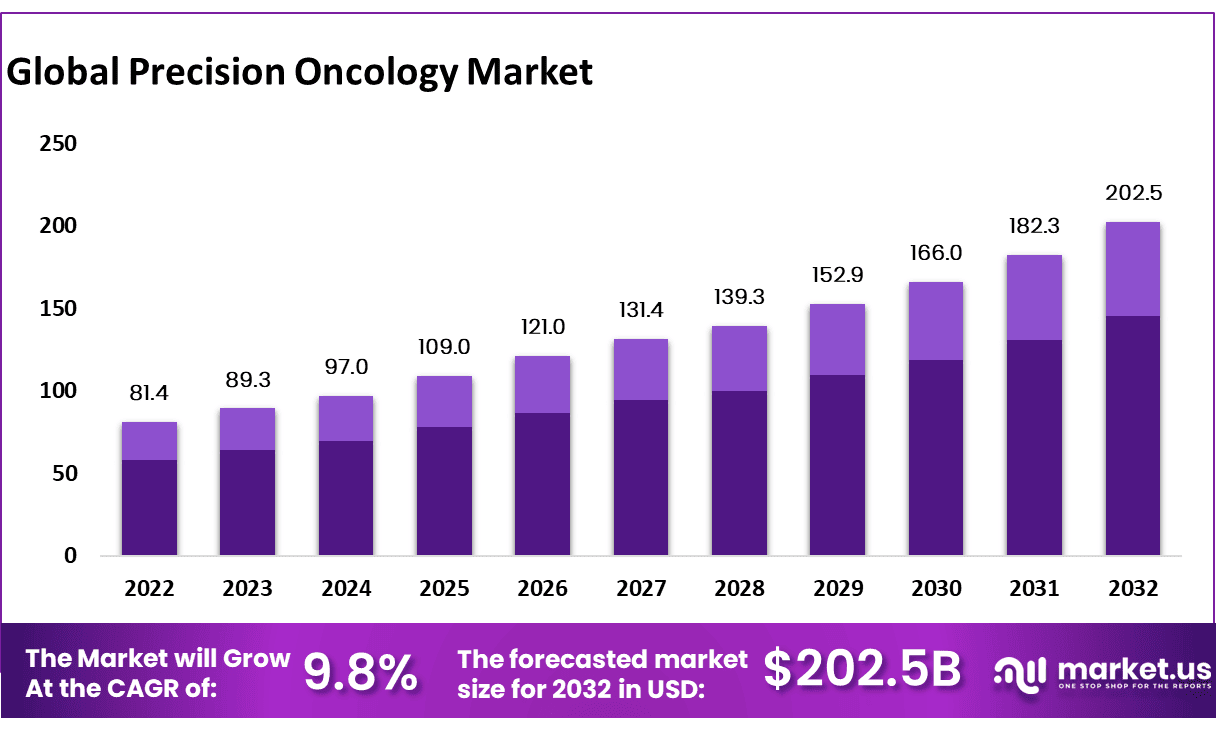
Precision Medicine Statistics – By Country
Precision medicine is a global concept, and its implementations and advancements are varying from country to country. Here is an overview of precision medicine and developments in several top countries.
The United States
The United States is the leading country in the global precision medicine market. The flagship project of the initiative is the All of Us Research Program. Which seeks to collect health data from one million or more volunteers to create a diverse research cohort.
- The United States has adopted electronic health records, and about 90% of office-based physicians in the United States have adopted EHRs.
- Precision medicine has made a substantial impact on cancer treatment in the United States. According to the American Society of Clinical Oncology (ASCO), there were over 500 targeted therapies and immunotherapies approved for various types of cancer in 2021.
According to a survey by Statista,
- About 66% of adults in the United States have not heard of personalized medicine or precision medicine.
- Only 34% of adults in the United States have heard about personalized medicines.
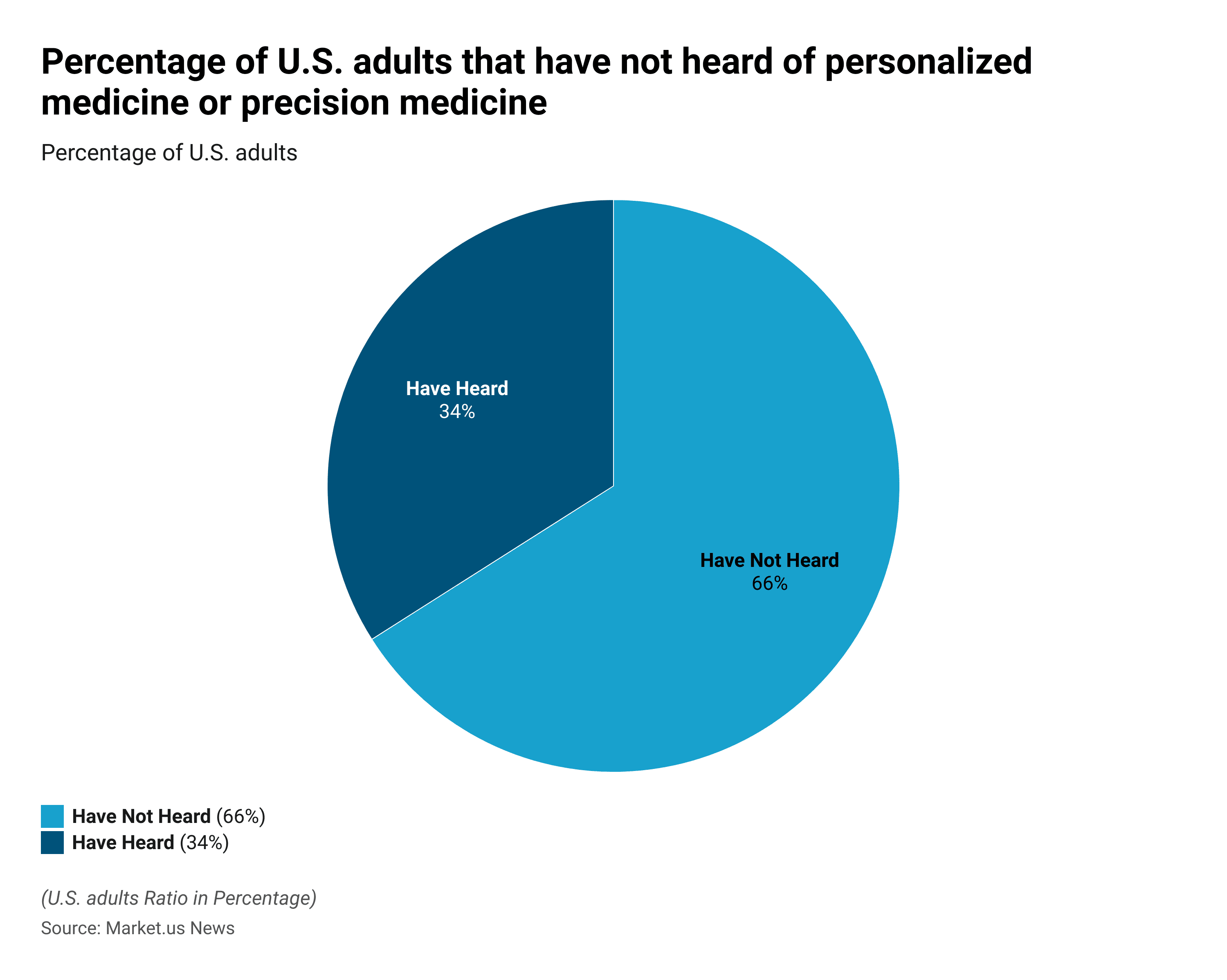
United Kingdom
The United Kingdom has started investing more and more in precision medicine statistics.
- There are more than 100,000 Genomic projects, launched in the United States in 2012 aimed to sequence genomes of 100,000 individuals with rare diseases. These projects led to the creation of Genomic England and the establishment of the NHS Genomic Medicine Service.
- The NHS Genomic Medicine Service launched a national program that aims to integrate genomic testing into routine healthcare.
- UK Biobank is a unique resource of data and samples linked to medical histories and health records from 500,000 adults.
Prescription Drugs in the United Kingdom
- The revenue of the prescription drugs segment in the UK is expected to reach a revenue of USD 39.99 billion at the end of the year 2023.
- The segment is expected to show a compound annual growth rate (CAGR 2023-2027) of 4.97%.
- In global comparison, most of the revenue in prescription medicine was created in the United States which is about USD 344.10 billion in the first quarter of 2023.
(Source: Statista)
China
The Chinese government is investing more and more in healthcare technology and precision medicines. The Chinese precision medicines initiatives, launched in 2016, focus on genomic research, genetic testing, and targeted therapies.
The diverse population of China is expected to provide significant opportunities in the precision medicine field. The revenue of healthcare in China is expected to reach USD 19.94 billion at the end of the year 2023, and the market is driving at a CAGR of 9.56% (2023-2027).
- The medical technology market in China accounted for a revenue of USD 42.29 billion in 2022.
- The medical devices segment accounted for the largest revenue of USD 31.24 billion in 2023.
- The medical technology market in China is growing at a CAGR of 7.39%.
- China’s Ministry of Science and Technology (MOST) launched a precision medicine project as a part of a national key research and development program.
- The MOST has invested about 1.3 billion yuan (USD 200.04 million) in 100 genomic projects.
- The potential of using big data to study health issues and chronic diseases is greater in China due to its larger population.
- The West China Hospital is available for genetic sequencing, which has funding of 50 million yuan annually.
- China’s National GeneBank in Shenzhen, which is operated by Beijing Genome Institute, has more than 500 million genetic sequences of over 8,000 species stored in more than 40 databases.
(Source: Nature, Statista, forum)
Oncology Precision Medicine Market CAGR by Regional Statistics
- From 2020 to 2030 the CAGR for the global oncology precision medicine market is expected to be 11.2 percent.
- The global oncology precision medicine market is expected to grow at a CAGR of 11.2% by 2027.
- The Asia Pacific region is expected to dominate the market with a CAGR of 13.9%.
- North America, Europe, and Latin America are expected to grow at the fastest CAGR in the forecast period.
(Source: Statista)
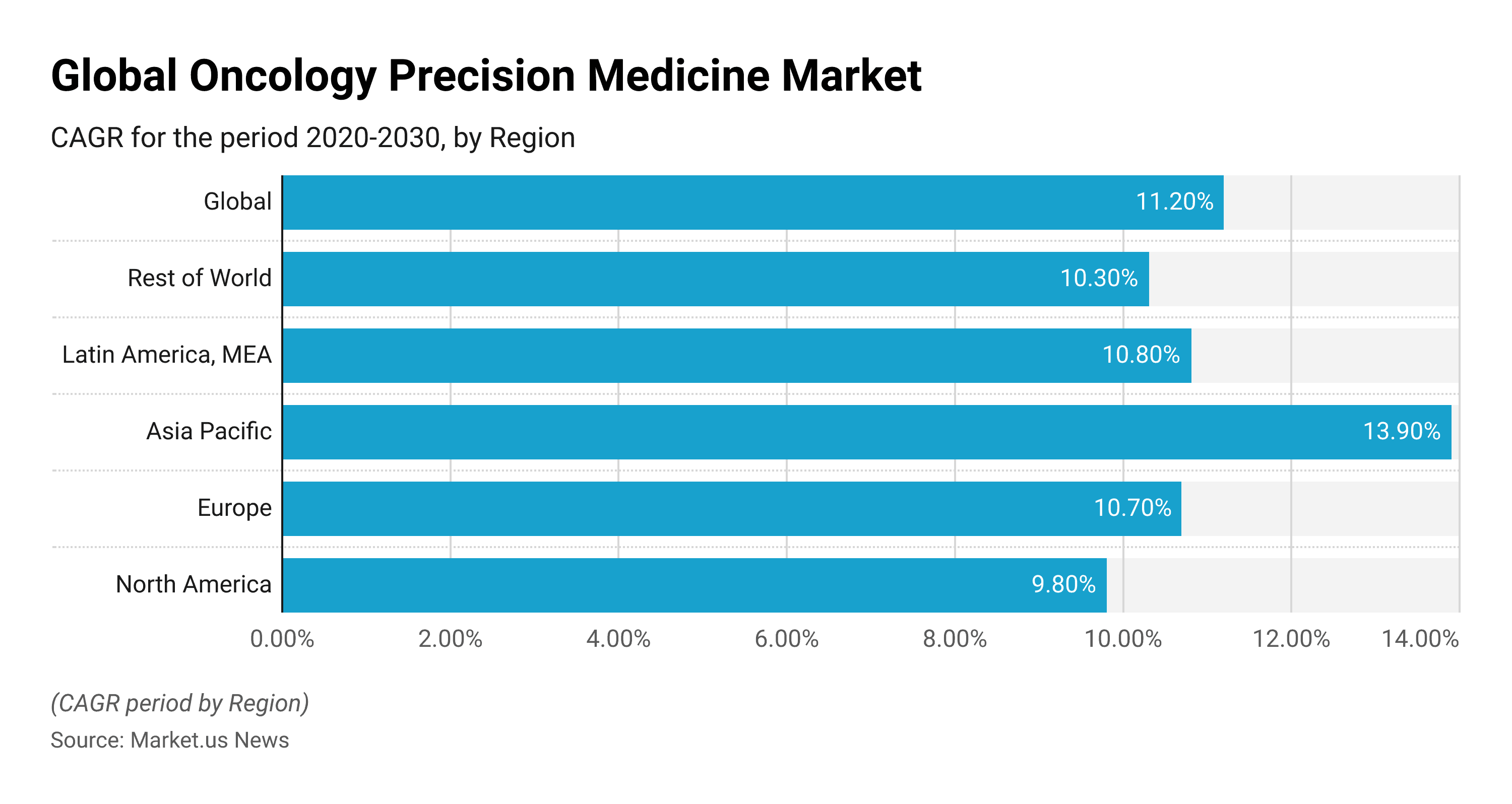
Total Non-Oncology Precision Medicine Market Worldwide in 2019 And A Forecast for 2030 Statistics
- In 2019, the total non-oncology precision medicine market accounted for revenue of USD 41.1 billion.
- It is expected that the market will grow at a revenue of USD 129.9 billion by 2032.
(Source: Statista)
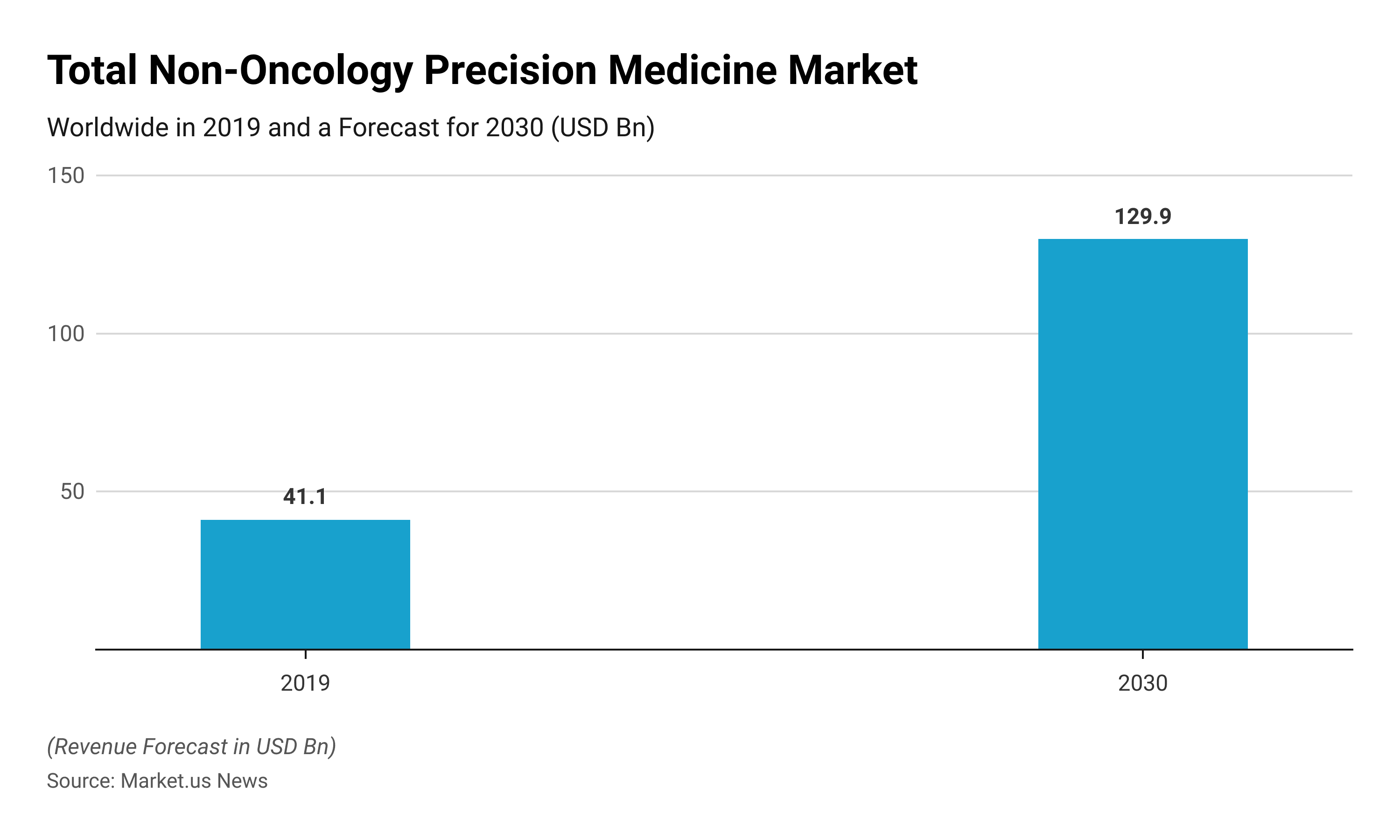
Precision Medicine and DNA Sequencing Statistics
DNA sequencing plays an important role in precision medicine. This involves determining the exact order of building blocks of DNA (adenine, thymine, cytosine, and guanine) in the individual genome. This genomics information helps in providing valuable insights into an individual’s genetic structure.
Global DNA Sequencing with Precision Medicine Market Statistics
- According to market.us, in 2022, the Global DNA Sequencing Market was valued at US$ 10.1 billion.
- Between 2023 and 2032, this market is estimated to register the highest CAGR of 15.3% with revenue of USD 40.5 billion by 2032.
- The DNA sequencing market was dominated by North America, which holds the largest market revenue of USD 4.4 billion.
(Source: Statista)
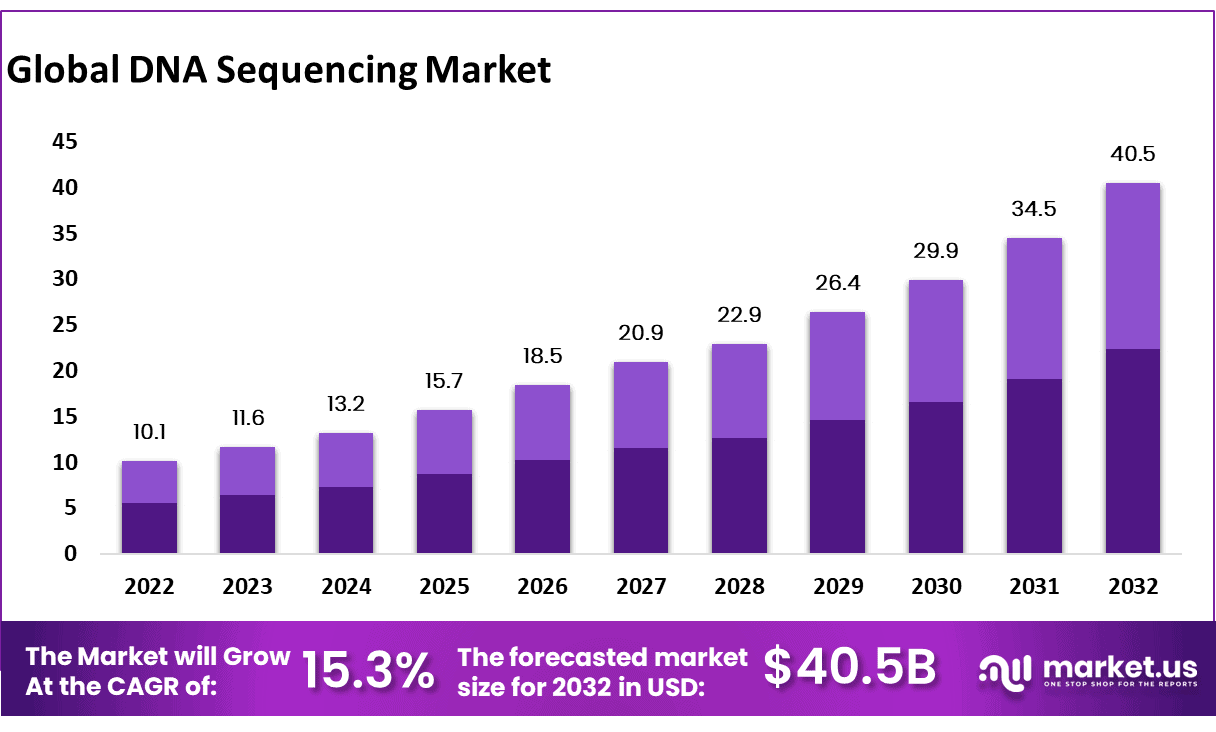
COVID-19 Impact on Precision Medicine Statistics
The emergence of the coronavirus disease 2019 (COVID-19) has affected the precision medicine market, affecting all healthcare areas. Surgery and tissue testing were hampered by the pandemic, which may have increased the number of advanced cancers in the future.
There were significantly fewer breast biopsy recommendations with cancer diagnoses from March to September 2020 compared to 2019 (1,650 in 2020 versus 2,171 in 2019, or 24% fewer in 2020) due to fewer screen-detected cancers, according to data published in 2021 by the Breast Cancer Surveillance Consortium (BCSC).
Precision medicine relies on a collection of various types of patient data, including genomic information, health records, and lifestyle factors. The demand for wearables, mobile health apps, and remote monitoring services increased during the COVID-19 pandemic.
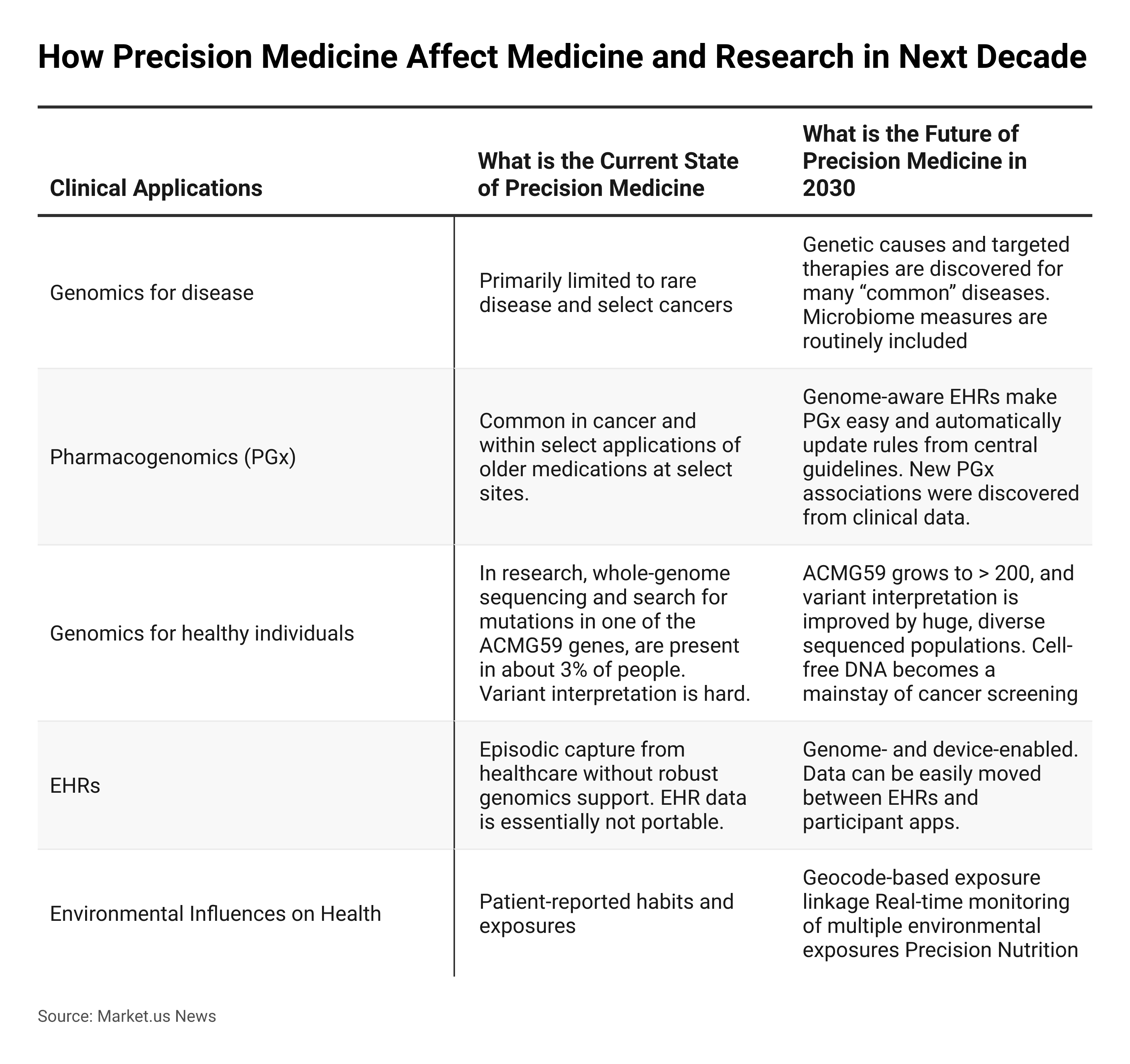
Precision Medicine’s Top Key Players
- Synapse, Inc.
- E. Healthcare
- AB-Biotics SA
- Abbott Laboratories
- HealthCore, Inc.
- Hoffmann-La Roche AG
- Johnson & Johnson
- Eli Lilly and Company
- Novartis AG
- Other Key players
Recent Developments
Acquisitions and Mergers:
- HealthTech Inc. acquired PrecisionCare Solutions for $800 million, consolidating its position in the precision medicine market and expanding its portfolio of personalized healthcare services.
- BioMed Innovations merged with GenomicHealth Technologies, forming a strategic partnership to advance precision medicine research and development efforts, with combined expertise in genetic testing and analysis.
New Product Launches:
- GenoMed unveiled a next-generation sequencing platform for genetic testing, offering comprehensive DNA analysis and personalized treatment recommendations, aiming to reach 1 million tests processed within the first year.
- Therapix introduced a precision oncology therapy targeting specific genetic mutations, demonstrating promising results in clinical trials with a 60% improvement in progression-free survival rates.
Funding Rounds:
- PrecisionCure received $150 million in Series C funding led by Healthcare Investment Group to expand their precision medicine platform and invest in artificial intelligence algorithms for data analysis, aiming for a 50% increase in patient enrollment within the next year.
- GeneHealth secured $80 million in seed funding from Biotech Investors to develop innovative diagnostics for rare genetic disorders and establish partnerships with pharmaceutical companies for precision medicine research, aiming for a 40% growth in revenue over the next fiscal year.
Consumer Trends:
- Rising awareness of personalized healthcare and genomic testing fueled the demand for precision medicine services, with genetic testing sales increasing by 30% compared to the previous year.
- Adoption of precision oncology therapies surged, with a 40% increase in prescriptions for targeted cancer treatments, reflecting growing acceptance of precision medicine approaches in oncology practice.
Regulatory Landscape:
- Regulatory agencies implemented guidelines for genetic testing and precision medicine applications, ensuring adherence to quality standards and patient safety in the precision medicine market.
Wrap Up
Precision Medicine Statistics – Precision medicine holds great promise for transforming the healthcare industry by tailoring medical interventions to individual patients based on their unique genetic, environmental, and lifestyle factors.
It utilizes genomic sequencing, advanced analytics, and digital health technologies to enable greater insight into the genetic basis of diseases. Identification of at-risk individuals, selection of targeted therapies, and monitoring of treatment response.
Precision medicine holds great potential to revolutionize healthcare by transitioning away from a one-size-fits-all approach to a more precise, patient-centered model.
Countries worldwide have realized the significance of precision medicine and have initiated various initiatives and research projects to accelerate its implementation.
The field of precision medicine is continuously evolving due to ongoing research, technological advancements, and the international collaboration of leaders.
FAQ’s
Precision medicine is also known as personalized medicine or individualized medicine. Which is an approach to healthcare that takes into account individual variability in genes, environment, and lifestyle when making medical decisions for patients.
According to market.us, the global precision medicine market size is expected to be worth around USD 254 Bn by 2032 from USD 83.4 Bn in 2022. Growing at a CAGR of 12.1% during the forecast period from 2022 to 2032.
– Improved disease prevention and early detection through genetic risk assessment and screening.
– Enhanced accuracy in diagnosis and classification of diseases.
– Customized treatment selection based on an individual’s genetic profile.
– Reduced adverse drug reactions and treatment-related side effects.
– More effective and targeted therapies.
– Patient empowerment through personalized healthcare decisions.
In 2022, the Global Precision Oncology Market was valued at USD 81.37 billion. Between 2023 and 2032, this market is estimated to register a CAGR of 9.8%. In 2032, it is estimated to be valued at USD 202.5 billion.
Discuss your needs with our analyst
Please share your requirements with more details so our analyst can check if they can solve your problem(s)



